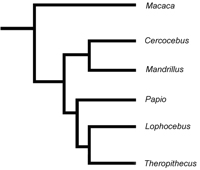A Reclassification of the Baboons
 In the past, drills and mandrills were called 'forest baboons' and classified with savanna baboons in the genus Papio. In the 1980s, they were recognized as being distinct from the baboons by the International Commission on Zoological Nomenclature (an organization responsible for the classification and naming of the animal kingdom) and were placed in their own unique genus - Mandrillus. Studies that led to this reclassification looked at both morphology and molecular DNA. The drill and mandrill are thought to be a branch that diverged from the baboons far back in evolutionary time.
In the past, drills and mandrills were called 'forest baboons' and classified with savanna baboons in the genus Papio. In the 1980s, they were recognized as being distinct from the baboons by the International Commission on Zoological Nomenclature (an organization responsible for the classification and naming of the animal kingdom) and were placed in their own unique genus - Mandrillus. Studies that led to this reclassification looked at both morphology and molecular DNA. The drill and mandrill are thought to be a branch that diverged from the baboons far back in evolutionary time.
The closest relative of the Mandrillus genus is another little known West African primate - the mangabey (genus Cercocebus). Mangabeys are also forest dwelling, but are smaller - somewhere between the size of the long-tailed guenon monkeys and Mandrillus. Mangabeys have long tails and are more arboreal than the two Mandrillus species, but have similar tooth and forearm morphology and are likely to have similar diets (i.e. they are both specialists in cracking seeds).























